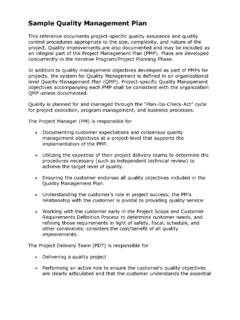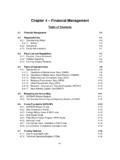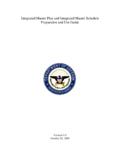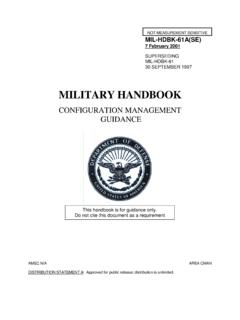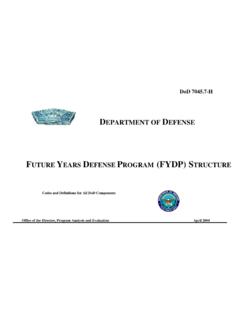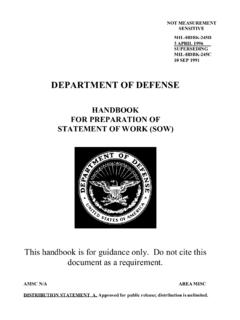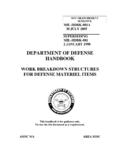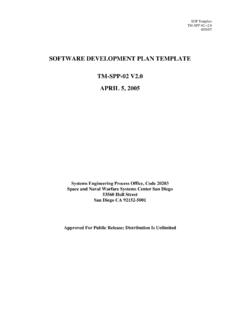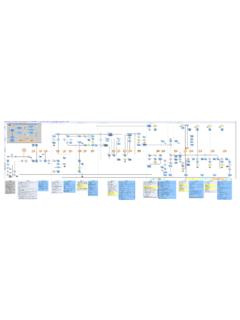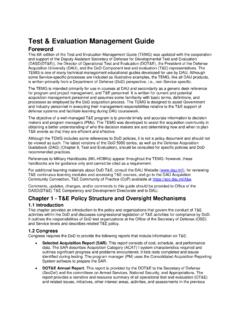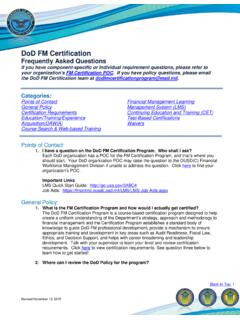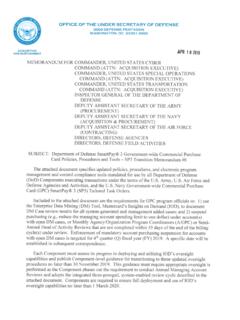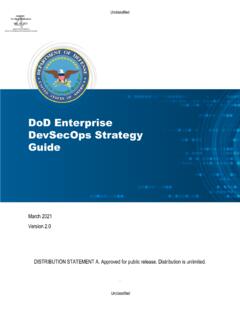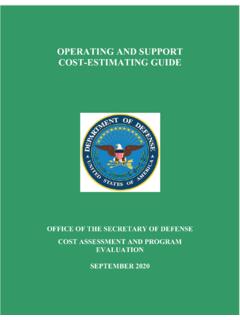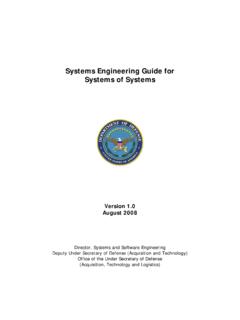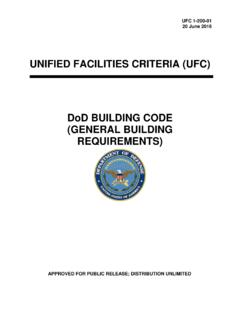Transcription of DOD RELIABILITY, AVAILABILITY, AND MAINTAINABILITY
1 DOD GUIDE FOR ACHIEVING. RELIABILITY, AVAILABILITY, AND MAINTAINABILITY . Systems Engineering for Mission Success . AUGUST 3, 2005. Foreword i RAM Guide: Table of Contents Chapter 1 - Reliability, Availability, MAINTAINABILITY , and the department of defense Introduction 1-1. - RAM Defined 1-1. Reliability 1-1. Availability 1-1. MAINTAINABILITY 1-1. Factors Affecting RAM 1-1. Importance of RAM 1-2. Readiness 1-2. System Safety 1-2. Mission Success 1-3. Total Ownership Cost 1-3. Logistics Footprint 1-3. The Current RAM Problem with Military Systems 1-3. The Steps to Achieving Satisfactory RAM 1-6. Step 1: Understand and Document User Needs and Constraints 1-7. Step 2: Design and Redesign for RAM 1-9. Step 3: Produce Reliable and Maintainable Systems 1-14. Step 4: Monitor Field Performance 1-16. Senior Management's Role 1-17. Chapter 2 Achieving RAM in Military Systems Introduction 2-1.
2 - Step 1: Understand and Document User Needs and Constraints 2-6. Mission and Goals for Step 1 2-7. Organizations and People for Step 1 2-8. Supporting Information for Step 1 2-8. Tools and Activities for Step 1 2-9. Outputs and Documentation for Step 1 2-14. Step 2: Design and Redesign for RAM 2-14. Mission and Goals for Step 2 2-15. Organizations and People for Step 2 2-16. Supporting Information for Step 2 2-17. Tools and Activities for Step 2 2-17. Outputs and Documentation for Step 2 2-22. Step 3: Produce Reliable and Maintainable Systems 2-23. Mission and Goals for Step 3 2-23. Organizations and People for Step 3 2-24. Supporting Information for Step 3 2-24. Tools and Activities for Step 3 2-24. Outputs and Documentation for Step 3 2-26. Step 4: Monitor Field Experience 2-27. Mission and Goals for Step 4 2-27. Organizations and People for Step 4 2-28.
3 Supporting Information for Step 4 2-28. Tools and Activities for Step 4 2-29. ii RAM Guide: Table of Contents Outputs and Documentation for Step 4 2-30. acquisition Framework and Program Integration 2-30. Current Process for Defining User Needs 2-30. Current acquisition Framework 2-31. Chapter 3 Understand and Document User Needs and Constraints Introduction 3-1. Missions and Goals 3-3. General Considerations in Developing Metrics 3-3. Reliability Metrics 3-4. MAINTAINABILITY Metrics 3-7. Availability Metrics 3-8. Organizations and People 3-13. Supporting Information 3-14. Tools and Activities 3-14. Development of a Conceptual System 3-15. Consideration of COTS versus New Development 3-18. - Representative System Model Construction 3-19. Perform Preliminary RAM Assessment 3-19. Formulate RAM Rationale 3-22. Construct Preliminary RAM Program Plan 3-25.
4 RAM Case Development 3-29. Initial Technical Review (ITR) 3-31. Alternative System Review (ASR) 3-32. System Requirements Review (SRR) 3-32. Integrated Baseline Review (IBR) 3-32. Outputs and Documentation 3-32. Chapter 4 Design and Redesign for RAM. Introduction 4-1. Mission and Goals 4-1. People and Organizations 4-2. Supporting Information 4-2. Input Information 4-2. Developed Information 4-3. Tools and Activities 4-3. Develop RAM Program Plan 4-3. RAM Design and Development Techniques 4-6. Technical Reviews 4-71. Outputs and Documentation 4-73. Chapter 5 Produce Reliable and Maintainable Systems Introduction 5-1. Mission and Goals 5-1. People and Organizations 5-3. Supporting Information 5-4. iii RAM Guide: Table of Contents Input Information 5-4. Developed Information 5-4. Tools and Activities 5-5. Develop Production RAM Program Plan 5-5. Provide Contractual Incentives and Contractor Oversight 5-5.
5 Plan and Conduct Operational Test and Evaluation 5-7. Participate in RAM Related ECP and Diagnostic Software Reviews 5-10. Environmental Stress Screening 5-11. Highly Accelerated Stress Screens 5-12. Lot Acceptance Testing 5-13. Production Reliability Assurance Testing 5-14. Continuation of Growth/TAFT 5-16. Continued Maintenance/ MAINTAINABILITY Demonstration and Evaluation 5-16. Continued RQT and Acceptance Testing 5-17. DCACAS 5-17. Quality and Quality Control Techniques 5-18. System Verification Review (SVR) 5-19. Production Readiness Review (PRR) 5-19. Operational Test Readiness Review (OTRR) 5-20. Physical Configuration Audit (PCA) 5-20. Outputs and Documentation 5-20. Chapter 6 Monitor Field Performance Introduction 6-1. Mission and Goals 6-1. Manage the RAM Sustainment Program 6-2. Identify RAM Problems and Prioritize Solutions 6-2. Identify Opportunities for Improving RAM 6-4.
6 Provide Lessons Learned to the acquisition and Capability Development Community 6-5. People and Organizations 6-6. Supporting Information 6-7. Tools and Activities 6-7. Data Collection, Analysis, and Corrective Action System (DCACAS) 6-8. Failure Modes and Effects Analysis 6-13. Reliability Growth Testing/Test-Analyze-Fix-Test 6-13. Life Data Analysis 6-13. Field Assessment and System Trending 6-14. Repair Strategy 6-15. Reliability Centered Maintenance (RCM) 6-15. Condition-Based Maintenance (CBM) 6-17. Parts Obsolescence and Diminishing Manufacturing Sources 6-18. In-Service Review (ISR) 6-18. Outputs and Documentation 6-19. Appendices iv RAM Guide: Table of Contents Appendix A Proposals and Contracts A-1. Appendix B Software Reliability B-1. Appendix C Reliability Growth Management Reliability Maturation Metrics for Failure Mode Coverage and Fix Effectiveness C-1.
7 Reliability Growth Tracking C-3. Reliability Projection C-9. Reliability Growth Planning C-17. Appendix D Field Assessment and System Trending D-1. Point Process Models D-2. Homogeneous Poisson Process (HPP) D-4. Non-Homogeneous Poisson Process (NHPP) D-4. Trend Analysis of System Failure Data D-6. Plotting Cumulative Failures vs. Cumulative Operation Time D-6. Laplace Test Statistic D-7. Glossary of Acronyms G-1. References Chapter 1 R-1. Chapter 2 R-1. Chapter 3 R-3. Chapter 4 R-4. Chapter 5 R-7. Chapter 6 R-7. Appendix A R-8. Appendix B R-8. Appendix C R-9. Appendix D R-10. v RAM Guide: Chapter 1 RAM and the department of defense Chapter 1 Reliability, Availability, MAINTAINABILITY , and the department of defense Introduction The primary objective of department of defense (DoD) acquisition is to acquire quality products (systems) that satisfy user needs with measurable improvements to mission capability and operational support in a timely manner, and at a fair and reasonable This guide supports that objective.
8 It addresses reliability, availability, and MAINTAINABILITY (RAM) as essential elements of mission capability. It focuses on what can be done to achieve satisfactory levels of RAM and how to assess RAM. This chapter introduces RAM, what it is, why it is important, current RAM problems in the DoD, and activities appropriate to achieving satisfactory levels. These topics are developed further in subsequent chapters. RAM Defined RAM refers to three related characteristics of a system and its operational support: reliability, availability, and MAINTAINABILITY . Reliability Reliability is the probability of an item to perform a required function under stated conditions for a specified period of time. Reliability is further divided into mission reliability and logistics reliability. For further information see Sections and Availability Availability is a measure of the degree to which an item is in an operable state and can be committed at the start of a mission when the mission is called for at an unknown (random) point in time.
9 Availability as measured by the user is a function of how often failures occur and corrective maintenance is required, how often preventative maintenance is performed, how quickly indicated failures can be isolated and repaired, how quickly preventive maintenance tasks can be performed, and how long logistics support delays contribute to down time. MAINTAINABILITY MAINTAINABILITY is the ability of an item to be retained in, or restored to, a specified condition when maintenance is performed by personnel having specified skill levels, using prescribed procedures and resources, at each prescribed level of maintenance and repair. Factors Affecting RAM. Many factors are important to RAM: system design; manufacturing quality; the environment in which the system is transported, handled, stored, and operated; the design and development of the support system; the level of training and skills of the people operating and maintaining the system; the availability of materiel required to repair the system; and the diagnostic aids and 1.
10 DoD Directive , The defense acquisition System, May 12, 2003, Paragraph , page 2. 1-1. RAM Guide: Chapter 1 RAM and the department of defense tools (instrumentation) available to them. All these factors must be understood to achieve a system with a desired level of RAM. During pre-systems acquisition , the most important activity is to understand the users' needs and constraints. During system development, the most important RAM activity is to identify potential failure mechanisms and to make design changes to remove them. During production, the most important RAM activity is to ensure quality in manufacturing so that the inherent RAM qualities of the design are not degraded. Finally, in operations and support, the most important RAM activity is to monitor performance in order to facilitate retention of RAM capability, to enable improvements in design (if there is to be a new design increment), or of the support system (including the support concept, spare parts storage, etc.)
